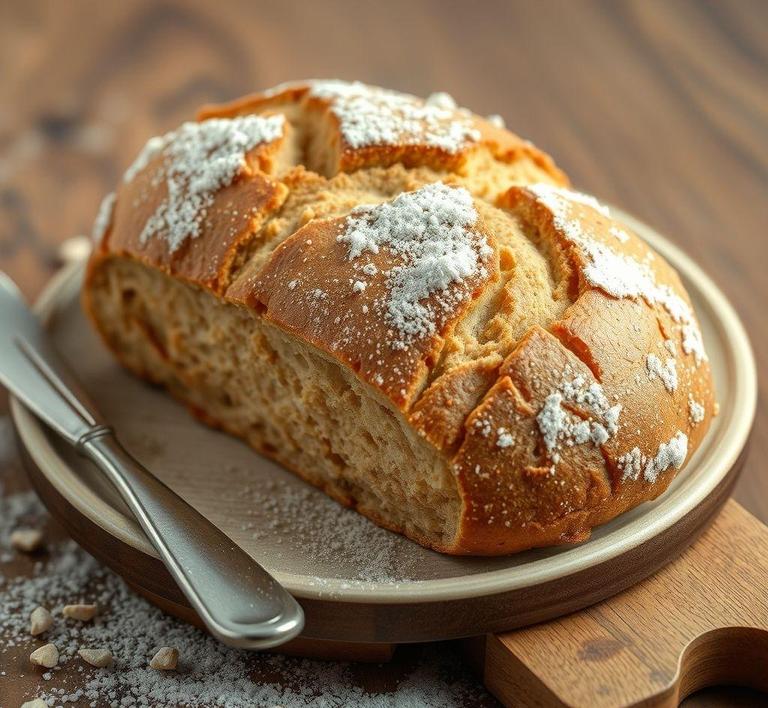Soda bread is one of those comforting, no-fuss loaves that’s perfect for any occasion, but what happens when you bake too much and need to store it for later? You might be wondering, can you refreeze soda bread? The good news is yes, you can! In this guide, we’ll walk you through how to properly refreeze soda bread so it stays fresh and delicious for weeks to come. Whether you’ve got leftovers from a big meal or want to prepare in advance for busy days, we’ve got all the tips to make sure your soda bread stays soft and tasty once it’s defrosted again.
Can You Refreeze Soda Bread?

Yes, you can refreeze soda bread, but with some caveats. Soda bread, unlike yeasted bread, is leavened with baking soda and buttermilk, which gives it a unique texture that is more crumbly and tender. This makes it more sensitive to the rigors of freezing and thawing.
When soda bread is frozen and then thawed, its moisture distribution changes. If the bread has already been defrosted and then refrozen, it may suffer further textural degradation, leading to increased dryness, crumbliness, or even sogginess depending on how it was handled during defrosting. However, if you’re mindful of the process and take steps to minimize exposure to air and moisture shifts, it’s absolutely possible to refreeze it with acceptable results.
The key lies in how it was stored initially, how long it was thawed, and how quickly it is refrozen. If the soda bread was defrosted in the refrigerator and kept cold, and has not been left at room temperature for more than two hours, it’s generally safe to refreeze.
How To Refreeze Soda Bread?
If you decide to refreeze soda bread, following the correct method is crucial to maintain its safety and maximize the quality. Here’s a step-by-step guide:
-
Check the Bread’s Condition:
- Ensure the bread was defrosted in the refrigerator and hasn’t been sitting out. If it has been exposed to room temperature for extended periods (over 2 hours), it’s better not to refreeze it.
- Examine for any signs of mold or off smells. If there’s any question about its freshness, do not proceed with refreezing.
-
Slice Before Freezing:
- If not already sliced, consider slicing the soda bread before refreezing. This allows you to take out individual slices later without thawing the entire loaf, which prevents repeated thawing cycles.
-
Wrap it Properly:
- Use plastic wrap or foil to tightly seal the bread or individual slices. Then, place them into a freezer-safe zip-top bag or airtight container.
- Squeeze out as much air as possible to prevent freezer burn, which can severely affect the bread’s texture and flavor.
-
Label with Date:
- Clearly label the packaging with the date you’re refreezing it. Try to use it within 1 to 2 months for optimal quality.
-
Refreeze Promptly:
- Return the bread to the freezer as soon as possible. The longer it sits after being thawed, the higher the risk of microbial growth and flavor loss.
Quality Impact
Every freeze-thaw cycle affects the integrity of soda bread’s texture and taste, particularly because soda bread lacks the elasticity and moisture-retention of yeast-risen loaves.
Here’s what may happen upon refreezing:
-
Texture Changes:
Refrozen soda bread may become noticeably drier and more crumbly. The freezing process causes the water in the bread to form ice crystals, which rupture the cell walls and disrupt the crumb structure. Each cycle amplifies this effect.
-
Flavor Loss:
While freezing preserves food, it can also dull the nuanced flavors over time. Soda bread’s earthy tang, usually imparted by buttermilk, may become muted after multiple freezes.
-
Moisture Migration:
During freezing and thawing, moisture tends to move unevenly. If not well-wrapped, this can lead to freezer burn on the outer crust or a gummy interior after thawing.
-
Potential for Staling:
Freezing slows staling, but it doesn’t stop it entirely. Upon a second thaw, soda bread may taste slightly ‘stale’ or lose that freshly baked quality.
While the quality won’t be the same as fresh or even first-time-frozen bread, it can still be perfectly enjoyable, especially when gently reheated or toasted.
Refreezing soda bread is both feasible and safe under the right conditions, but it comes with a trade-off in texture and taste. If handled carefully – kept cold, wrapped properly, and not left out too long – soda bread can be refrozen without significant health risks.
However, for best results, consider freezing soda bread in single-use portions to avoid the need for refreezing altogether. If you do need to refreeze it, using it within a month and reheating it in an oven or toaster can help restore some of its original character.
Is It Safe To Refreeze Soda Bread?
Refreezing soda bread is a topic that garners mixed opinions, but the definitive answer hinges on one critical factor: how the bread was handled between freezing cycles. Technically, yes – it is safe to refreeze soda bread, but only under the right conditions. If the bread was previously frozen, thawed in the refrigerator, and has remained at a safe temperature (below 40°F or 4°C), refreezing poses minimal health risk. However, safety is only half the battle – the texture, moisture, and flavor of soda bread are also at stake.
Soda bread, known for its crumbly texture and dense interior, does not possess the high fat content of butter-rich breads like brioche or croissants. This means it is more susceptible to textural degradation from repeated freeze-thaw cycles. Moisture tends to separate and redistribute unevenly, leading to sogginess, ice crystals, and eventual staleness. That said, if the bread was stored properly and has not been left out at room temperature for more than two hours, refreezing can be a practical – if slightly imperfect – solution.
Signs That Soda Bread Should Not Be Refrozen
Not all bread is fit for a second round in the freezer. Before considering refreezing soda bread, be vigilant for the following telltale signs of spoilage or deterioration:
-
Unpleasant Odor:
Soda bread should have a mild, wheaty, and slightly tangy aroma (especially if made with buttermilk). If you detect a sour, musty, or yeasty smell that seems off, it’s best to discard the loaf.
-
Mold Growth:
Even a small spot of mold is a definitive no-go. Mold can quickly infiltrate the porous structure of soda bread, and freezing does not kill mold spores – it only halts their growth temporarily. Never refreeze bread with visible mold.
-
Dry, Crumbly Texture:
If the bread feels unusually dry, with a brittle or chalky consistency, chances are it’s already past its prime. Refreezing in this condition will only accelerate degradation, leading to an unappetizing result.
-
Excessive Ice Crystals:
If the soda bread was previously thawed improperly and developed ice crystals during storage, these can damage the structure of the bread. Refreezing in this state may yield a mushy, soggy mess when thawed again.
-
Room Temperature Storage Beyond Safe Limits:
If the bread was left out for more than two hours (or one hour in hot weather), it should not be refrozen. Bacteria such as Salmonella and Listeria can proliferate rapidly in the danger zone (40-140°F), making the bread unsafe even if no outward signs are visible.
Common Refreezing Mistakes
Refreezing bread might seem simple, but a few common missteps can turn your humble loaf into a kitchen disaster. Here are the pitfalls to avoid:
-
Thawing on the Countertop:
This is one of the biggest mistakes. Thawing soda bread at room temperature can allow bacteria to multiply, especially if it sits out for hours. Always thaw in the refrigerator to maintain a safe temperature.
-
Re-Freezing After Microwaving:
Some people attempt to thaw frozen bread quickly by microwaving it. While this might work in a pinch, microwaving partially "cooks" the bread, causing condensation and altering its structure. Refreezing it afterward results in significant loss of texture and flavor.
-
Freezing in Poor Packaging:
Bread that isn’t wrapped tightly allows air exposure, which leads to freezer burn – those unpleasant dry patches caused by dehydration and oxidation. If your soda bread was inadequately stored during its first freezing, the damage is likely irreversible, and a second freeze will worsen it.
-
Refreezing Whole Loaves Instead of Portions:
Refreezing an entire loaf after repeatedly slicing into it exposes the bread to fluctuating temperatures and moisture, increasing the risk of spoilage. Always freeze in pre-portioned slices if possible.
Tips and Tricks for Refreezing Soda Bread
If you must refreeze soda bread, do it the smart way. These practical tips will help preserve as much of the bread’s quality and safety as possible:
-
Freeze in Slices:
Before refreezing, cut the bread into manageable slices. This not only prevents waste (thaw only what you need!) but also reduces repeated freeze-thaw cycles.
-
Wrap Like a Pro:
Use plastic wrap followed by a layer of aluminum foil or a heavy-duty freezer bag to provide an airtight seal. This protects against freezer burn and odor absorption.
-
Label Clearly:
Always mark the date of refreezing. Frozen soda bread is best consumed within one month for optimal taste and texture, though it can technically be stored for up to three months.
-
Reheat Strategically:
When ready to use, reheat slices directly from frozen in a toaster or oven for the best results. This restores some of the bread’s original crustiness and masks any textural decline from freezing.
-
Don’t Refreeze Multiple Times:
Soda bread should ideally be frozen only once – or at most, twice – if the storage conditions have been ideal. Each cycle breaks down the bread’s structure further.
Conclusion
Refreezing soda bread is not without consequences, but when handled thoughtfully, it can be a convenient way to reduce food waste and make the most of homemade or store-bought loaves. Always assess the bread’s condition before refreezing – freshness, storage method, and safety are non-negotiable. Avoiding common mistakes like improper thawing or poor wrapping can preserve both flavor and texture. By slicing before freezing and storing in airtight packaging, you give your soda bread the best chance of surviving the cold – again. With a little care and culinary foresight, even the humble soda loaf can stand up to a second frost.


